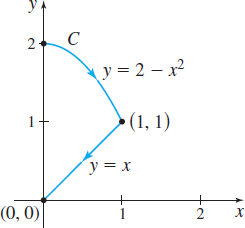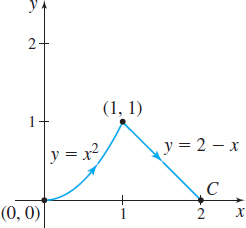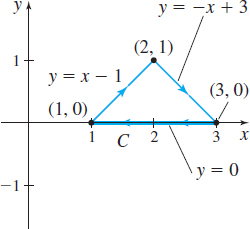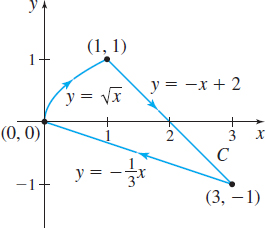15.2 Assess Your Understanding
987
Concepts and Vocabulary
Question
True or False A line integral \(\int_{C}f(x,y)\,ds\) is equal to a definite integral if \(C\) is a smooth curve defined on \([a,b]\), and if the function \(f\) is continuous on some region that contains the curve \(C.\)
Question
If \(C\) is a smooth curve defined by the parametric equations \(x=x(t)\) and \(y=y(t),\) \(a\leq t\leq b,\) and \(f\) is a function that is continuous on some region that contains the curve \(C\), then the line integral of \(f\) along \(C\) from \(t=a\) to \(t=b\) exists and is given by \(\int_{C}f(x,y)\,ds=\int_{a}^{b}\)__________\(dt\).
Question
True or False The value \(\int_{C}f(x,y)\,ds\) depends on the choice of the parametric equations used to represent the smooth curve \(C.\)
Question
If the variable mass density of a wire at a point \((x,y) \) is \(\rho (x,y) \), then the mass \(M\) of the wire can be found using the line integral _______, where \(C\) is the curve representing the shape of the wire.
Question
True or False \(\int_{-C}(P\,dx+Q\,dy)= \int_{C}(P\,dx-Q\,dy)\)
Question
True or False A piecewise-smooth curve \(C\) consists of a finite number of smooth curves that are joined together end to end.
Question
If a piecewise-smooth curve \(C\) consists of smooth curves \(C_{1},\,C_{2},\,\ldots ,\,C_{n},\) \(n\geq 2,\) then \(\int_{C}(P\,dx+Q\,dy)=\)_________.
Question
True or False Suppose \(C\) is a smooth curve defined by the parametric equations \(x=x(t),\) \(y=y(t),\) and \(z=z(t),\) \(\ a\leq t\leq b\), and \(P(x,y,z),\) \(Q(x,y,z),\) and \(R(x,y,z)\) are functions that are continuous on some solid in space containing \(C\), then \(\int_{C}P(x,y,z)\,dx=\int_{a}^{b}P( x(t) ,y(t) ,z(t) ) x(t) \,dt.\)
Skill Building
In Problems 9–14, find each line integral for the given smooth curve \(C\).
Question
\(\int_{C}x^{2}y\,ds;\quad C\): \(x=\cos t\), \(y=\cos t\) , \(0\leq t\leq \dfrac{\pi }{2}\)
Question
\(\int_{C}(y-x^{2})\, ds;\quad C\): \(x=t\), \(y=3t\), \(0\leq t\leq 1\)
Question
\(\int_{C}xy\,ds;\quad C\): \(x=t^{2},\) \(y=4t,\) \(0\leq t\leq 2\)
Question
\(\int_{C}x\,ds;\quad C\): \(x=t\), \(y=3t^{2}\), \(0\leq t\leq 1\)
Question
\(\int_{C}\dfrac{y}{2x^{2}-y^{2}}ds;\quad C\): \(x=t\), \(y=t\), \(1\leq t\leq 5\)
Question
\(\int_{C}\dfrac{x^{2}}{x^{3}+y^{3}}ds;\quad C\): \(x=3t\), \(y=4t\), \(1\leq t\leq 2\)
Question
Find \(\int_{C}2y\,ds\), where \(C\) is the curve \(y=\dfrac{1}{2}x^{3}\) joining \((0,0)\) to \((2,4)\).
Question
Find \(\int_{C}x\,ds\), where \(C\) is the curve \(x=5y^{3}\) joining \((0,0)\) to \((5,1)\).
Question
Find \(\int_{C}( xy+1) \,ds\), where \(C\) is the curve \(\mathbf{r}(t)=\sin t\mathbf{i}+\cos t\mathbf{j},\) \(0\leq t\leq \pi \).
Question
Find \(\int_{C}xy^{2}\,ds\), where \(C\) is the curve \(\mathbf{r}(t)=\cos t \mathbf{i}+\sin t\mathbf{j},\) \(0\leq t\leq \dfrac{\pi }{2}\).
In Problems 19–22, find each line integral along the two given curves \(C_{1} {\rm and} C_{2}.\)
Question
\(\int_{C}(x+y^{2})\,ds\)
- \(C_{1}\): \(\ x=t\), \(y=t\), \(0\leq t\leq 1\)
- \(C_{2}:\) \(\ x=\sin t\), \(y=\sin t\), \(0\leq t\leq \dfrac{\pi }{2}\)
Question
\(\int_{C}(x+y)\,ds\)
- \(C_{1}\): \(\ x=t\), \(y=3t\), \(0\leq t\leq 1\)
- \(C_{2}\): \(\ x=\sin (2t) \), \(y=3\sin (2t) ,\) \(0\leq t\leq \dfrac{\pi }{2}\)
Question
\(\int_{C}( x+e^{y}) \,ds\)
- \(C_{1}\): \(\ x=1-t\), \(y=t\), \(0\leq t\leq 1\)
- \(C_{2}\): \(\ x=\cos t\), \(y=1-\cos t\), \(0\leq t\leq \dfrac{\pi }{2}\)
Question
\(\int_{C}xe^{x^{2}}ds\)
- \(C_{1}\): \(\ x=t+1\), \(y=t\), \(0\leq t\leq 1\)
- \(C_{2}\): \(\ x=1+\sin t\), \(y=\sin t\), \(0\leq t\leq \dfrac{\pi }{2}\)
In Problems 23–26, find the line integral with respect to \(x\) and with respect to \(y\) for each function \(f(x,y)\) along the given curve \(C.\)
Question
\(f(x,y) =2x+y^{2}\) along the line \(y=3-x\) from \(\left( 0,3\right) \) to \((3,0) .\)
Question
\(f(x,y) =xe^{y}\) along the line \(2x-y=1\) from \((0,-1) \) to \((1,1) .\)
Question
\(f(x,y) =xe^{y}\) along the curve \(C\) traced out by \(x=e^{2y}\) from \(( 1,0) \) to \((e^{2},1) .\)
Question
\(f(x,y) =x^{2} y\) along the parabola \( x=2y^{2}\) from \((0,0) \) to \(( 2\pi ,\sqrt{\pi }) .\)
Question
Find \(\int_{C}(x^{2}y\,dx+xy\,dy)\) along the curve \(C\): \(x^{2}+y^{2}=1\) from \((1,0)\) to \((0,1)\) using the following parametric equations:
- \(x=\cos t\), \(y=\sin t\), \(0\leq t\leq \dfrac{\pi }{2}\)
- \(x=\sqrt{1-y^{2}}\), \(0\leq y\leq 1\)
Question
Find \(\int_{C}(xy\,dx+xy^{2}\,dy)\) along the curve \(C\): \(x^{2}+y^{2}=9\) from \((3,0)\) to \((-3,0)\) traced out by the parametric equations:
- \(x=3\cos t\), \(y=3\sin t\), \(0\leq t\leq \pi \)
- \(y=\sqrt{9-x^{2}}\), \(-3\leq x\leq 3\)
Question
Find \(\int_{C}[y^{2}\,dx+(xy-x^{2})\,dy]\) along each of the given curves from \((0,0)\) to \((1,3)\):
- \(C\) is the line \(y=3x\).
- \(C\) is the parabola \(y^{2}=9x\).
Question
Find \(\int_{C}[(x^{2}+y^{2})\,dx+3x^{2}y\,dy]\) along each of the given curves from \((-2,4)\) to \((2,4)\):
- \(C\) is the parabola \(y=x^{2}\).
- \(C\) is the line \(y=4\).
988
In Problems 31–34, find \(\int_{C}[(x+2y)\,dx+(2x+y)\,dy]\) along each curve \(C\).
Question
\(C\) is the curve \(y=x^{2}\) from \((0,0)\) to \((1,1)\).
Question
\(C\) is the curve \(y=x^{3}\) from \((0,0)\) to \((1,1)\).
Question
\(C\) is the curve \(x=\cos t\), \(y=\sin t\), \(0\leq t\leq \dfrac{\pi }{2}\).
Question
\(C\) is the curve \(x=1-t\), \(y=t\), \(0\leq t\leq 1\).
In Problems 35–38, find \(\int_{C}x\,ds\) along each piecewise-smooth curve \(C\).
Question

Question

Question

Question

Question
Find \(\int_{C}[(x\cos y)\,dx-(y\sin x)\,dy]\), where \(C\) consists of line segments connecting the points \((0,0)\), \((1,0)\), \((1,1)\) , and \((0,1)\), in that order.
Question
Find \(\int_{C}[(x\sin y)\,dx-(y\cos x)\,dy]\), where \(C\) consists of line segments connecting the points \((0,0)\), \((0,1)\), \((1,1)\), and \((1,0)\), in that order.
Question
Find \(\int_{C}(yz\,dx+xz\,dy+xy\,dz)\), where \(C\) consists of line segments connecting the points \((0,0,0)\), \((1,0,0)\), \((1,1,0)\), and \((1,1,1)\), in that order.
Question
Find \(\int_{C}[yz\,dx+(y+zx)\,dy+xz\,dz]\), where \(C\) consists of line segments connecting the points \((0,0,0)\), \((1,0,0)\), \((1,2,0)\), and \((1,2,1)\), in that order.
In Problems 43–46, find \(\int_{C}[ y\,dx+(x-{\it 16}y)\,dy] \) along each of the given curves from \({\rm (2, 0)}\) to \({\rm (0, 4)}\).
Question
The line segment joining the two points
Question
The parabola \(y=4-x^{2}\)
Question
The line segment from \((2,0)\) to \((2,2)\), followed by the line segment from \((2,2)\) to \((0,4)\).
Question
The parabola \(y=4-x^{2}\) from \(( 2,0) \) to \(( 1,3) ,\) followed by the line segment from \(( 1,3) \) to \(( 0,4) \).
In Problems 47–50, for each vector field \(\mathbf{F}\) and curve \(C\): \(\mathbf{r}=\mathbf{r}(t) ,\) find \(\int_{C}\mathbf{F}\,{\boldsymbol\cdot}\, d\mathbf{r}\).
Question
\(\mathbf{F}(x,y)=(x+2y)\mathbf{i}+(2x+y)\mathbf{j}\);
\(C\) is the curve \(\mathbf{r}(t)=t\mathbf{i}+t^{2}\mathbf{j}\), \(0\leq t\leq 1\).
Question
\(\mathbf{F}(x,y)=x^{2}\mathbf{i}+xy\mathbf{j}\)
\(C\) is the curve \(\mathbf{r}(t)=(\cos t)\mathbf{i}+(\sin t)\mathbf{j}\), \(0\leq t\leq \pi \).
Question
\(\mathbf{F}(x,y,z)=xy\mathbf{i}+x^{2}z\mathbf{j}+xyz\mathbf{k}\)
\(C\) is the curve \(\mathbf{r}(t)=e^{t}\mathbf{i}+e^{-t}\mathbf{j}+t^{2} \mathbf{k}\), \(0\leq t\leq 1\).
Question
\(\mathbf{F}(x,y,z)=y\mathbf{i}+x^{2}y\mathbf{j}+xz\mathbf{k}\)
\(C\) is the curve \(\mathbf{r}(t)=e^{2t}\mathbf{i}+e^{t}\mathbf{j}+t\mathbf{k}\), \(0\leq t\leq 1\).
In Problems 51–54, for each curve \(C\), find \(\int_{C}\mathbf{F}\,{\boldsymbol\cdot}\, d\mathbf{r}\) if \(\mathbf{F}(x,y,z)=xy\mathbf{i}-y \mathbf{j}+z\mathbf{k}\).
Question
\(C\) is the line segment from \((0,0,0)\) to \((1,0,0)\).
Question
\(C\) is the line segment from \((1,0,0)\) to \((1,2,0)\).
Question
\(C\) is the line segment from \((1,2,0)\) to \((1,2,3)\).
Question
\(C\) is the line segment from \((0,0,0)\) to \((1,2,3)\).
In Problems 55–58 find the lateral surface area \(A\) of the cylinder that lies above the \(xy\)-plane and below the surface \(z=f(x,y)\) and is formed by lines parallel to the \(z\)-axis and intersecting \(C\).
Question
\(z=f(x,y)=1-x^{2};\quad C\): \(x=\sin t\), \(y=\cos t\), \(0\leq t\leq 2\pi \)
Question
\(z=f(x,y)=1-y^{2};\quad C\): \(x=\sin t\), \(y=\cos t\), \(0\leq t\leq 2\pi \)
Question
\(z=f(x,y)=2xy;\quad C\): \(y=\sqrt{1-x^{2}}\), \(0\leq x\leq 1\)
Question
\(z=f(x,y)=x+y;\quad C\): \(y=\sqrt{1-x^{2}}\), \(0\leq x\leq 1\)
Applications and Extensions
Question
Find \(\int_{C}\dfrac{\,ds}{x^{2}+y^{2}+z^{2}}\), where \(C\) is the helix \(x=a\cos t\), \(y=a\sin t\), \(z=bt\), \(0\leq t\leq 1\).
Question
Find \(\int_{C}(y^{n}\,dx+x^{n}\,dy)\), where \(C\) is the ellipse \(x=a\sin t\), \(y=b\cos t\), \(0\leq t\leq 2\pi \), and \(n \ge 1\) is an integer.
Question
Find \(\int_{C}y^{2}\,ds\), where \(C\) is the first arch of the cycloid \(x=a(t-\sin t)\), \(y=a(1-\cos t)\).
Question
Find \(\int_{C}\sqrt{x^{2}+y^{2}}\,ds\), where \(C\) is the curve \(x=a(\cos t+t\sin t)\), \(y=a(\sin t-t\cos t)\), \(0\leq t\leq 2\pi \), \(a > 0\).
Question
Find \(\int_{C}(z\,dx+x\,dy+y\,dz)\), where \(C\) is the circular helix \(x=a\cos t\), \(y=a\sin t\), \(z=t\), \(0\leq t\leq 2\pi \).
Question
Find \(\int_{C}[xz\,dx+(y+z)\,dy+x\,dz]\), where \(C\) is the curve \(x=e^{t}\), \(y=e^{-t}\), \(z=e^{2t}\) from \(t=0\) to \(t=1\).
Mass of a Wire In Problems 65 and 66, find the mass \(M\) of a thin wire in the shape of the curve \(C\) whose variable mass density is \(\rho \).
Question
\(C\): \(y=x^{2}\), \(1\leq x\leq 2;\quad \rho =\rho (x,y)=4x\)
Question
\(C\): \(x=3\sin t\), \(y=3\cos t\), \(0\leq t\leq \dfrac{\pi }{2};\quad \rho =\rho (x,y)=x+y+1\)
Question
Mass of a Wire Find the mass of a thin wire in the shape of a parabola \(x=2t^{2},\) \(y=t\), \(-2\leq t\leq 3\), if the variable mass density of the wire is \(\rho (x,y) =3x.\)
Question
Mass of a Wire Find the mass of a thin wire in the shape of a parabola \(x=t,\) \(y=t^{2}-1,\) \(0\leq t\leq 3,\) if the variable mass density of the wire is \(\rho (x,y) =x\left( y+1\right) .\)
Question
Mass of a Wire A spring is made of a thin wire twisted into the shape of a circular helix \(x=2\cos t\), \(y=2\sin t,\) \(z=t.\) Find the mass of two turns of the spring if the wire has constant mass density \(\rho\).
989
Question
Mass of a Wire A spring is made of a thin wire twisted into the shape of a circular helix \(x=3\sin t\), \(y=3\cos t,\) \(z=t.\) Find the mass of two turns of the spring if the wire has variable mass density \(\rho ( x,y,z) =z+2.\)
Question
Mass of a Wire in Space Write a formula similar to \(M=\int_{C}\rho (x,y)\, ds\) for the mass of a thin wire in the shape of a smooth space curve \(C\) whose variable mass density is \(\rho =\rho (x,y,z)\).
In Problems 72–74, use the formula developed in Problem 71 to find the mass of each wire.
Question
Mass of a Wire in Space The thin wire is in the shape of the helix \(C\): \(x=2\cos t\), \(y=2\sin t\), \(z=5t\), \(0\leq t\leq 2\pi \), whose mass density is \(\rho (x,y,z)=k\), a constant.
Question
Mass of a Wire in Space The thin wire is in the shape of a helix \(C\): \(x=3\cos t\), \(y=3\sin t\), \(z=4t\), \(0\leq t\leq 2\pi \), whose variable mass density is \(\rho (x,y,z)=2+z\).
Question
Mass of a Wire in Space The thin wire is in the shape of a helix \(C\): \(x=2\cos t\), \(y=2\sin t\), \(z=5t\), \(0\leq t\leq 2\pi \), if the mass density is proportional to the square of the distance from the origin.
Question
Lateral Surface Area Derive the formula \(A=2\pi Rh\) for the surface area of a right circular cylinder using the line integral \(\int_{C}f(x,y)\,ds\), where \(z=f(x,y)=h\), \(h>0\), and \(C\) is the circle \(x^{2}+y^{2}=R^{2}\).
Question
Let \(C_{1}\) be the curve \(x=\cos \theta \), \(y=\sin \theta \), \(0\leq \theta \leq 4\pi \), and let \(C_{2}\) be the curve \(x=\cos t^{2}\), \(y=\sin t^{2}\), \(0\leq t\leq 2\sqrt{\pi }\). For \(P(x,y) =x^{3}y\) and \(Q(x,y) =y^{2}x\), show that \(\int_{C_{1}}(P\,dx+Q\,dy)=\int_{C_{2}}(P\,dx+Q\,dy)\). Explain why this is so.
Challenge Problems
Question
Find \(\int_{C}(x+y)\,ds\), where \(C\) is the curve \(x=t\), \(y=\dfrac{3t^{2}}{\sqrt{2}}\), \(0\leq t\leq 1\).
Question
Center of Mass Find the center of mass of a homogeneous wire in the shape of the hypocycloid
- \( x=a\cos ^{3}t,y=a\sin ^{3}t,\ 0\leq t\leq \dfrac{\pi }{2}\)
- \( x=a\cos ^{3}t,y=a\sin ^{3}t,\ 0\leq t\leq 2\pi \)
Question
Suppose the line integral of \(f(x,y)\) along the curve \(C\) exists.
- Use the Mean Value Theorem to derive the formula \[ \int_{C}f(x,y)\,ds=\int_{a}^{b}f(x(t),y(t))\sqrt{\left( \dfrac{dx}{dt} \right) ^{\!\!2}+\left( \dfrac{dy}{dt}\right) ^{\!\!2}}\,dt \]
- Apply the formula in (a) to the quantity \(S(t)=\int_{a}^{t}\sqrt{(x')^2+(y')^2}\,du\), where \(S' (t_{0})\) is the length of the portion of the curve traced out as \(t\) moves from \(a\) to \(t_{0}\).
Question
It follows from Problem 79 that the value of a line integral of a function along a smooth curve, given the hypotheses of the theorem, is independent of the parameterization. Why? In particular, if \(x\) and \(y\) are differentiable functions of the arc length as one moves along the curve, describe what form the integral \[ \int_{C}f(x,y)\,ds=\int_{a}^{b}f(x(t),y(t)) \sqrt{\left( \dfrac{dx}{dt}\right) ^{\!\!2}+\left( \dfrac{dy}{dt}\right) ^{\!\!2}} \,dt \]
takes when \(s\) is used as the parameter.
Question
We have seen two kinds of line integrals: \(\int_{C}( P\,dx+Q\,dy) \) and \(\int_{C}f\,ds\). These are closely connected.
- If \(C\) is expressed using arc length as the parameter, show that \(\int_{c}(Pdx + Qdy)\) can be written in the form \(\int_{c} fds\).
- If the arc length \(s\) along \(C\) can be expressed as a function of \(x\) and \(y\), show that \(\int_{c}fds\) can be written in the form \(\int_{c}(Pdx + Qdy)\). For example, \[ \int_{C}(x+y^{2})\,ds=\int_{C}\left[\dfrac{x^{2}+xy^{2}}{\sqrt{x^{2}+y^{2}}}\,dx+ \dfrac{xy+y^{3}}{\sqrt{x^{2}+y^{2}}}\,dy\right] \] where \(C\) is the curve \(x=t\), \(y=t\), for \(0\leq t\leq 1\).
